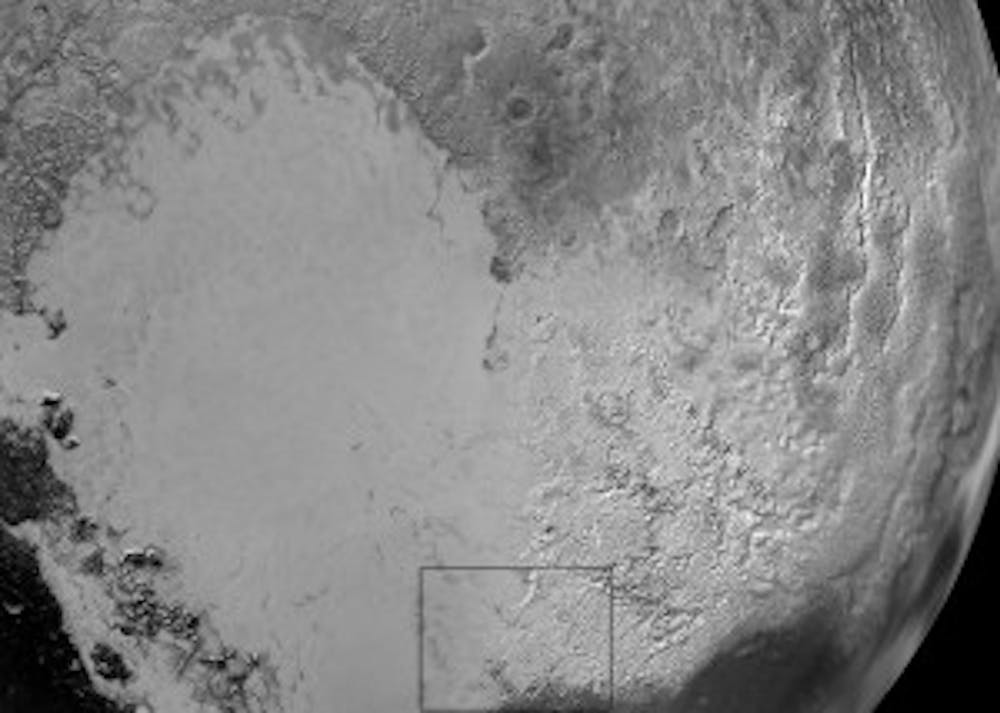By ELIZABETH LIU
Icy mountain ranges cast shadows into frozen valleys and lumpy hills blend into frosty plains on Pluto, as is evident in the images from the space probe New Horizons. And now we can see the images with even more clarity with the arrival of new higher resolution images from the frigid corners of the solar system.
New Horizons’s journey started on Jan. 19, 2006 when it was launched from Cape Canaveral, Fla. into outer space. The spacecraft was created by the Johns Hopkins University Applied Physics Laboratory and is part of the National Aeronautics and Space Administration’s (NASA) New Frontiers program, a series of space missions designed to explore and research several planets in our solar system including Jupiter, Venus and the dwarf planet Pluto.
After an encounter with asteroid 132524 APL (previously named 2002 JF56) on June 11, 2006, New Horizons passed by Jupiter, getting in a very close and cozy range of 1.4 million kilometers on Feb. 28, 2007. On June 8, 2008, the spacecraft zipped past Saturn’s orbit and, nearly three years later, passed by Uranus’s orbit. About a year ago the tiny probe crossed Neptune’s orbital path, heading toward Pluto. In April of this year, New Horizons started taking color photos of the dwarf planet and sending the data back to Earth.
The images surprised nearly everyone — Pluto, often described as an icy orb, seemed to have deep valleys and gigantic mountains whose heights may be comparable to those of the Rocky Mountains. The enormousness of these steep mountains was unexpected; scientists originally thought that Pluto’s surface was mainly covered in nitrogen ice, methane ice and carbon dioxide ice, which are too malleable to create mountains of that size. The only substance that could be consistent with the development of these mountains, according to the researchers, would be water ice. This idea supports several previous hypotheses that Pluto has a rocky core with an outer layer of ice.
The new images from Pluto arrived in mid-September, about two months after the photos were taken. The time it takes for NASA to download the pictures is generally about that length — data from the space probe gets transferred at roughly 2,000 bits per second. Compared to an old dial-up modem, which transfers data at 56,000 bits per second, the transfer speed of the spacecraft is a snail’s pace. Some photos were not even single snapshots but rather a conglomeration of multiple pictures synthesized into one, and these took even longer to transfer.
Currently NASA projects that it will take about a year for all of the data to arrive at Earth. However, looking at the quality of the latest pictures, many would likely agree that it is worth the wait. Each photograph reveals that, although the dwarf planet is completely frozen over, the intricate landscape is still changing and developing.
The closest New Horizons got to Pluto was a mere 50,000 million miles away on July 14. The photos taken on that day reveal what seems to be dunes. However, according to the scientists analyzing the images, this would be pretty much impossible for Pluto, a celestial body with almost no atmosphere. A possible explanation is that Pluto had a thicker atmosphere in the past with winds that were able to create dunes.
The space probe is expected to end its encounter with Pluto by January of next year. The researchers are anticipating the new images, which should arrive in December 2016 at the very latest. With New Horizons, NASA’s New Frontiers mission completes what NASA calls the “reconnaissance of the classical star system.” New Horizons also makes the United States the first country to send a spacecraft to every planet (and dwarf planet) in our solar system.





